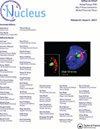Workshop on RanBP2/Nup358 and acute necrotizing encephalopathy
IF 4.5
3区 生物学
Q3 CELL BIOLOGY
引用次数: 7
Abstract
ABSTRACT Dominant missense mutations in RanBP2/Nup358 cause Acute Necrotizing Encephalopathy (ANE), a pediatric disease where seemingly healthy individuals develop a cytokine storm that is restricted to the central nervous system in response to viral infection. Untreated, this condition leads to seizures, coma, long-term neurological damage and a high rate of mortality. The exact mechanism by which RanBP2 mutations contribute to the development of ANE remains elusive. In November 2021, a number of clinicians and basic scientists presented their work on this disease and on the interactions between RanBP2/Nup358, viral infections, the innate immune response and other cellular processes.RanBP2/Nup358与急性坏死性脑病研讨会
RanBP2/Nup358的显性错义突变导致急性坏死性脑病(ANE),这是一种儿科疾病,在这种疾病中,看似健康的个体在对病毒感染的反应中产生一种仅限于中枢神经系统的细胞因子风暴。如果不治疗,这种情况会导致癫痫发作、昏迷、长期神经损伤和高死亡率。RanBP2突变促进ANE发展的确切机制尚不清楚。2021年11月,一些临床医生和基础科学家介绍了他们在这种疾病以及RanBP2/Nup358、病毒感染、先天免疫反应和其他细胞过程之间相互作用方面的工作。
本文章由计算机程序翻译,如有差异,请以英文原文为准。
求助全文
约1分钟内获得全文
求助全文
来源期刊

Nucleus
CELL BIOLOGY-
CiteScore
5.60
自引率
5.40%
发文量
16
审稿时长
13 weeks
期刊介绍:
Nucleus is a fully open access peer-reviewed journal. All articles will (if accepted) be available for anyone to read anywhere, at any time immediately on publication.
Aims & Scope: The eukaryotic cell nucleus is more than a storage organelle for genomic DNA. It is involved in critical steps of cell signaling and gene regulation, as well as the maintenance of genome stability, including DNA replication and DNA damage repair. These activities heavily depend on the spatial and temporal “functional” organization of the nucleus and its integration into the complex meshwork of cellular scaffolding.
Nucleus provides a platform for presenting and discussing cutting-edge research on all aspects of biology of the cell nucleus. It brings together a multidisciplinary community of scientists working in the areas of:
• Nuclear structure and dynamics
• Subnuclear organelles
• Chromatin organization
• Nuclear transport
• DNA replication and DNA damage repair
• Gene expression and RNA processing
• Nucleus in signaling and development
Nucleus offers a variety of paper formats including:
• Original Research articles
• Short Reports
• Reviews
• Commentaries
• Extra Views
• Methods manuscripts.
 求助内容:
求助内容: 应助结果提醒方式:
应助结果提醒方式:


